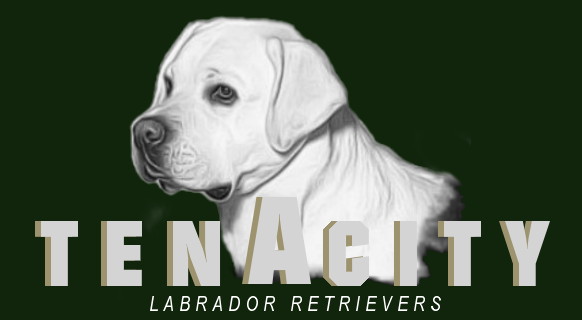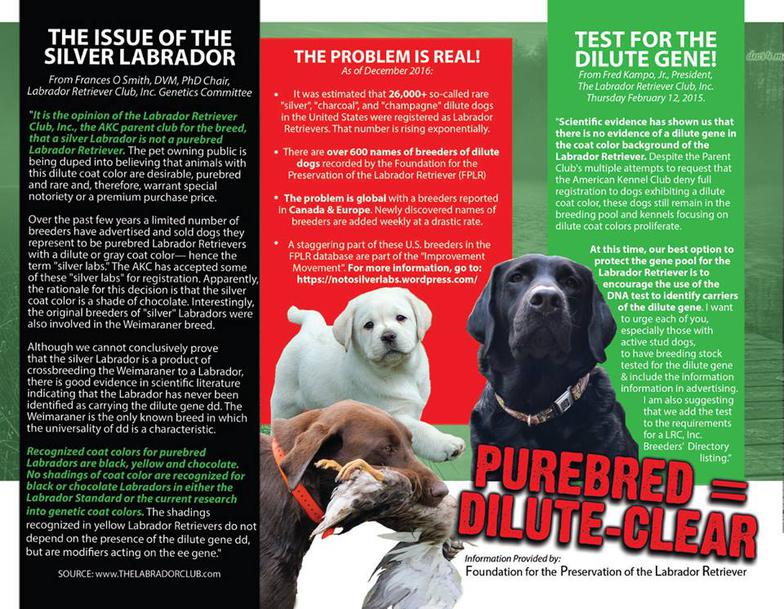TRUE LABRADOR RETRIEVERS ARE BLACK, YELLOW, AND CHOCOLATE ONLY!
The Issue of the Silver Labrador
Frances O Smith, DVM, PhD Chair, Labrador Retriever Club, Inc. Genetics Committee
It is the opinion of the Labrador Retriever Club, Inc., the AKC parent club for the breed, that a silver Labrador is not a purebred Labrador retriever. The pet owning public is being duped into believing that animals with this dilute coat color are desirable, purebred and rare and, therefore, warrant special notoriety or a premium purchase price.
Over the past few years a limited number of breeders have advertised and sold dogs they represent to be purebred Labrador Retrievers with a dilute or gray coat color—hence the term “silver labs.” The AKC has accepted some of these “silver labs” for registration. Apparently, the rationale for this decision is that the silver coat color is a shade of chocolate. Interestingly, the original breeders of “silver” Labradors were also involved in the Weimaraner breed.
Although we cannot conclusively prove that the silver Labrador is a product of crossbreeding the Weimaraner to a Labrador, there is good evidence in scientific literature indicating that the Labrador has never been identified as carrying the dilute gene dd. The Weimaraner is the only known breed in which the universality of dd is a characteristic.
From the website of Vetgen:
The D locus is the primary locus associated with diluted pigment, which results in coats that would otherwise be black or brown instead showing up as gray or blue, in the case of black, and pale brown in the case of brown. The melanophilin gene has recently been shown to be responsible, but not all of the dilute causing mutations have been identified yet.
Recognized coat colors for purebred Labradors are black, yellow and chocolate. No shadings of coat color are recognized for black or chocolate Labradors in either the Labrador Standard or the current research into genetic coat colors. The shadings recognized in yellow Labrador Retrievers do not depend on the presence of the dilute gene dd, but are modifiers acting on the ee gene. The identified coat color genes in the Labrador include:
The omission of “d,” and thus the impossibility of a dd dilute gene resulting from a pure Labrador breeding, is certainly persuasive evidence that the silver Labrador is not a purebred.
It's a bit of a problem when it comes to breeding because recessive traits, such as [recessives] and dilution, can remain hidden in lines for many generations, then suddenly crop up when a dog carrying the trait is bred to another with it (if the gene is very rare in the breed then it can be a long time until this happens, if it ever does). This is why breedings sometimes throw complete surprises, like silver (blue) Labrador puppies in a breed, which, to all intents and purposes, contains no silver at all. That one lone recessive silver gene (d, on the D locus) has been passed down from generation to generation, completely unknown to the breeders, until finally it's met another one. It might have come from a cross-breeding with another breed many years ago, which doesn't show up on the pedigrees and no longer has any effect on the look of the dog (so all the dogs in the line look exactly like normal Labradors, not a crossbred), but they still carry one gene left over from the cross-breeding). Such rare recessive traits can be impossible to eradicate from a breed, simply because you can't tell which dogs carry them. However, in recent years, genetic testing has helped to identify the carriers.
No Kennel Club in the world accepts any color that differs from these three.
Please see the refer to the breed standard as per the Labrador Retriever Club of Canada!
The Truth about silver labs
Coat color and the clubs position on dilute


